Charles Bernstein Interview
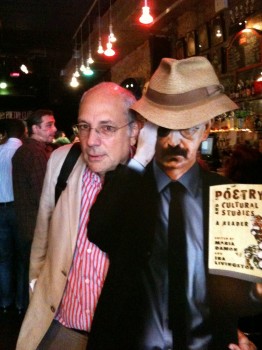
Charles Bernstein lending a hat to Walter Benjamin
Much enjoyed the Chicago interview Charles Bernstein gave to Daniel Benjamin for the Chicago Weekly while in that town a week. or two ago. Below, a short extract. Go here to read the whole shmear/schmier (which may be a Yiddish word in New York, but where I come from it is Letzebuergesch and refers to a really mighty slice of bread with butter and whatever else you like on it. most satisfying, morning, noon or night).
L=A=N=G=U=A=G=E assembled a compendium of samples, a range of activities that had no natural place of their own, no proper place. Here I would use the term of Michel de Certeau and say we were about tactics because we were not able to have a strategy. Certeau speaks about strategy as being for someone that has the high ground, the proper space; tactics are activities that undermine those controlling interests. Although I’d also say that it’s not just tactical, that what’s needed is a poetics of tactics, so there is of a larger reflection on the nature of how those tactics operate. In that sense, L=A=N=G=U=A=G=E was a constellation of tactics without an underlying principle, except perhaps Joe Hill’s: don’t mourn, organize. The absence of an underlying principle is, I think, what I mean by “imaginary” in my initial reply to you; I think it’s crucial to why the magazine may have resonance now (if it does). Often poetry groupings have more to do with commitments to a specific style or to a particular social milieu. “Not that there’s anything wrong with that!”, as Seinfeld would say. But either I wasn’t interested in that or maybe it’s just that in New York in the mid-’70s I was too much on the periphery of the art and poetry and performance subcultures that I found most attractive, and I didn’t find any one style that I wanted to marry either. So we made something up! But eclecticism was not our thing either.
L=A=N=G=U=A=G=E was a montage. We were about constellation not juxtaposition. It was all about picking and choosing to create a palpable, compelling even tantalizing sense of the possibilities for poetry, all the time acknowledging the history we felt ourselves extending. And forging friendships and commitments as we went along.
I understand this kind of approach isn’t for all poets, or maybe even for most poets, many of whom would find so much organizing a distraction. But for me—and this takes me through the rest of my life—organizing is a poetic practice. I think of poetry, marginal though it is, as a fundamental activity within our culture. I think of it as historical, cognitive, philosophical, aesthetic work. Because I think that, I try to put things together that might not go together at first—but then, after not too long, it might seem they were—almost—a natural fit. And for me it also means mapping poetic work onto multiple cultural spaces, some expected some not—the internet, universities, reading series, the visual arts, music, film, little magazines, performance, publishing, radio.
With L=A=N=G=U=A=G=E, there were a number of poets who were in conversation, engaged in a discussion of the linguistic turn, of the significance of verbal language as a perceptual membrane that changes the way we see the world, of the possibilities of continuing formal invention within poetry and the social implications of such invention, and of the relation of voices to voicing, found materials to made patterns, parts to wholes, standardization to conformity …
L=A=N=G=U=A=G=E is syncretic. Our conversations melded into an alloy. And there is one more crucial element, maybe most important of all: our commitment to non-expository modes of discursive thinking; to new essays forms engaged with nonlinear thinking. Essays, poetics as a crucial part of the work of poetry …

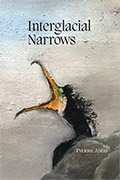 “Interglacial Narrows (Poems 1915-2021)” Contra Mundum Press
“Interglacial Narrows (Poems 1915-2021)” Contra Mundum Press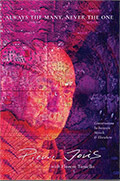 “Always the Many, Never the One: Conversations In-between, with Florent Toniello” Contra Mundum Press
“Always the Many, Never the One: Conversations In-between, with Florent Toniello” Contra Mundum Press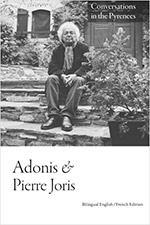 “Conversations in the Pyrenees”
“Conversations in the Pyrenees”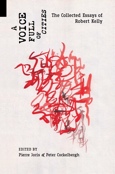 “A Voice Full of Cities: The Collected Essays of Robert Kelly.” Edited by Pierre Joris & Peter Cockelbergh
“A Voice Full of Cities: The Collected Essays of Robert Kelly.” Edited by Pierre Joris & Peter Cockelbergh “An American Suite” (Poems) —Inpatient Press
“An American Suite” (Poems) —Inpatient Press “Arabia (not so) Deserta” : Essays on Maghrebi & Mashreqi Writing & Culture
“Arabia (not so) Deserta” : Essays on Maghrebi & Mashreqi Writing & Culture “Barzakh” (Poems 2000-2012)
“Barzakh” (Poems 2000-2012) “Fox-trails, -tales & -trots”
“Fox-trails, -tales & -trots”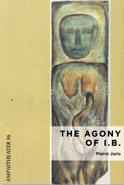 “The Agony of I.B.” — A play. Editions PHI & TNL 2016
“The Agony of I.B.” — A play. Editions PHI & TNL 2016 “The Book of U / Le livre des cormorans”
“The Book of U / Le livre des cormorans”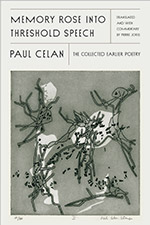 “Memory Rose Into Threshold Speech: The Collected Earlier Poetry of Paul Celan”
“Memory Rose Into Threshold Speech: The Collected Earlier Poetry of Paul Celan”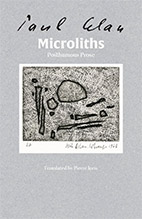 “Paul Celan, Microliths They Are, Little Stones”
“Paul Celan, Microliths They Are, Little Stones”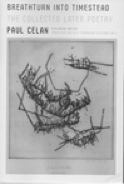 “Paul Celan: Breathturn into Timestead-The Collected Later Poetry.” Translated & with commentary by Pierre Joris. Farrar, Straus & Giroux
“Paul Celan: Breathturn into Timestead-The Collected Later Poetry.” Translated & with commentary by Pierre Joris. Farrar, Straus & Giroux